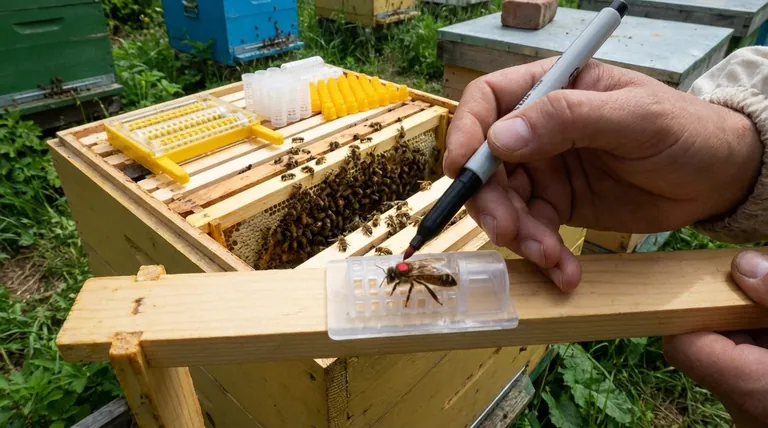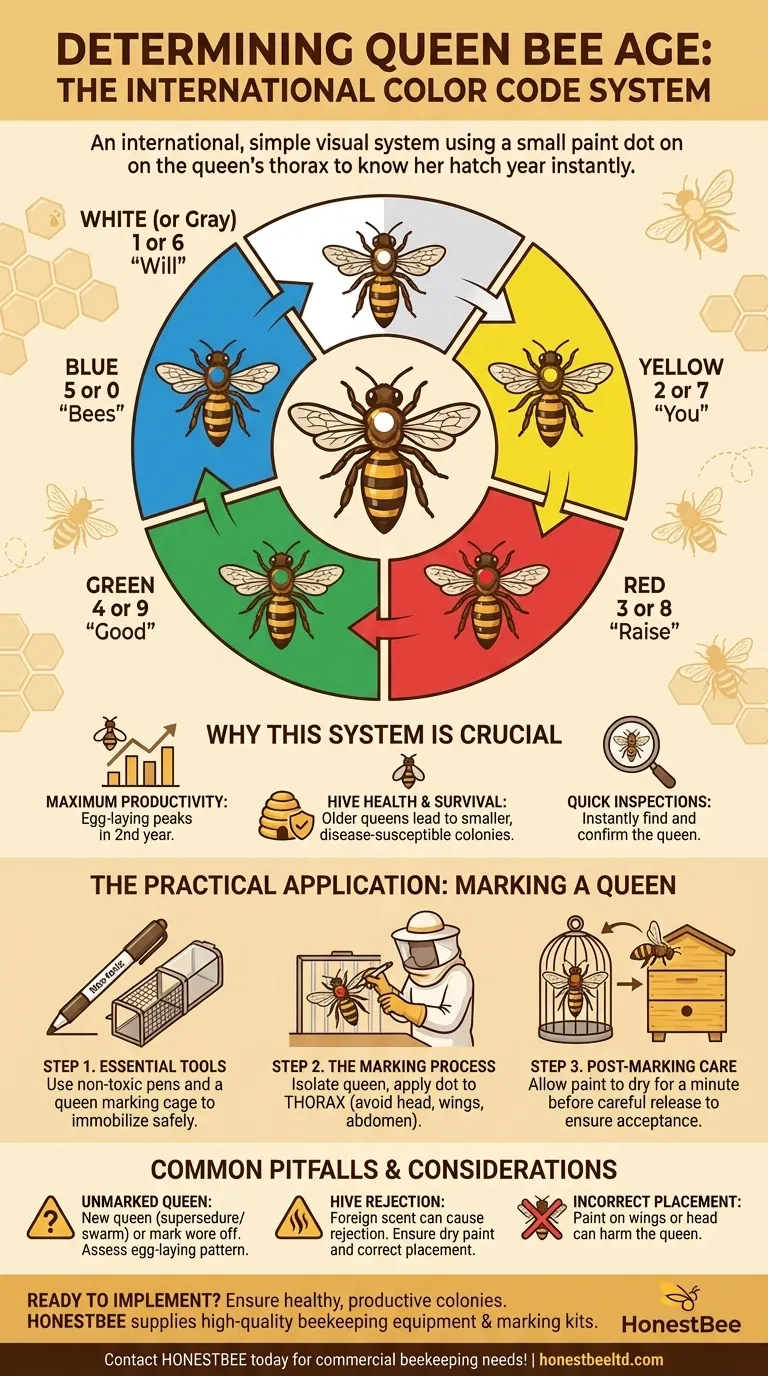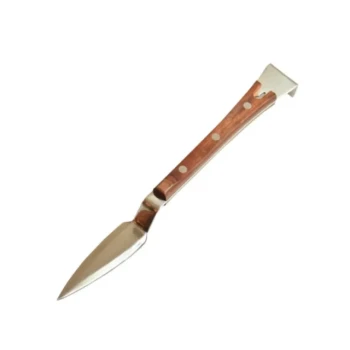In beekeeping, a queen's age is not a guess; it's a known fact. Beekeepers determine the year a queen hatched by applying a small, color-coded dot of paint to her thorax. This international system assigns a specific color to the final digit of the year, allowing a beekeeper to identify a queen's age at a single glance.
Knowing a queen's age is fundamental to managing a healthy and productive honey bee colony. The international queen marking color code is a simple, visual system that removes all ambiguity, empowering beekeepers to make critical decisions about their hives.

The International Queen Marking Color Code
The entire system is designed for rapid identification. Since a queen bee rarely lives longer than five years, a rotation of five distinct colors is all that is needed to track her age effectively.
How the System Works
The color used to mark a queen corresponds to the last digit of the year she was hatched and raised. This creates a 5-year repeating cycle that is easy for any beekeeper worldwide to understand.
A common mnemonic to remember the order is "Will You Raise Good Bees?" The first letter of each word corresponds to the color for years ending in 1/6, 2/7, 3/8, 4/9, and 5/0.
The Color Code Breakdown
The five colors are always used in the same sequence, making the system predictable and reliable.
- White (or Gray): For years ending in 1 or 6
- Yellow: For years ending in 2 or 7
- Red: For years ending in 3 or 8
- Green: For years ending in 4 or 9
- Blue: For years ending in 5 or 0
For example, a queen hatched in 2023 would be marked with a red dot. A queen from 2024 would be marked green.
Why This System is Crucial
Knowing the queen's age allows a beekeeper to manage the hive proactively. A queen's egg-laying productivity typically peaks in her second year and begins to decline afterward.
An older queen can lead to a smaller, less productive colony that is more susceptible to disease and less likely to survive the winter. Marking provides an instant data point for when to consider replacing her.
The Practical Application: How to Mark a Queen
Marking a queen requires a steady hand and the right equipment, but the process is straightforward. The goal is to apply the mark safely without harming or stressing the queen.
Essential Tools
Beekeepers use specially designed, non-toxic queen marking pens that are safe for bees.
To handle the queen safely, a queen marking cage or a "one-handed queen catcher" is often used. These tools gently immobilize the queen, exposing her thorax for easy marking without the risk of crushing her.
The Marking Process
The process involves finding the queen on a frame of bees and carefully isolating her. She is then gently corralled into the marking cage.
Once she is still, a small dot of the correct color paint is applied to the center of her thorax (the middle section of her body). It's critical to avoid painting her wings, head, or abdomen.
The paint must be allowed to dry for a minute before she is carefully released back onto the frame to ensure the scent dissipates and her colony readily accepts her.
Common Pitfalls and Considerations
While the system is effective, it's important to understand its limitations and potential issues.
The Unmarked Queen
If you find a queen with no mark, it means one of two things: she is a new queen that the colony raised itself (through supersedure or swarming), or the original mark has worn off.
In this situation, you cannot know her exact age. You must assess her quality based on her egg-laying pattern. If the brood pattern is solid and consistent, she is likely young and healthy.
Risk of Hive Rejection
Occasionally, the foreign scent of the paint can cause the worker bees to view the queen as an intruder. This risk is minimized by using proper queen marking pens and allowing the paint to dry completely before release.
Importance of Correct Placement
A poorly placed mark can be detrimental. Paint on the queen's wings can impede her flight, and paint near her head can block her spiracles (breathing pores). The thorax is the only safe and correct location for the mark.
Making the Right Choice for Your Apiary
Using the color code is a fundamental skill that directly impacts hive management strategy.
- If your primary focus is maximum productivity: Use the color code to proactively replace queens after their second season, ensuring the colony is always headed by a young, prolific queen.
- If your primary focus is colony survival and health: The mark allows you to quickly assess if a struggling hive might be suffering from a failing, older queen.
- If your primary focus is simple, at-a-glance inspections: The colored dot makes finding the queen—and confirming the hive is queenright—incredibly fast and efficient.
Ultimately, this simple marking system is one of the most powerful tools a beekeeper has for managing healthy, productive, and thriving colonies.
Summary Table:
| Year Ending In | Queen Marking Color | Mnemonic Word |
|---|---|---|
| 1 or 6 | White/Gray | Will |
| 2 or 7 | Yellow | You |
| 3 or 8 | Red | Raise |
| 4 or 9 | Green | Good |
| 5 or 0 | Blue | Bees |
Ready to implement this system in your apiary? Efficient hive management starts with the right tools. HONESTBEE supplies beekeepers and beekeeping equipment distributors with high-quality, wholesale-focused beekeeping supplies and equipment—including reliable queen marking kits. Ensure your colonies are healthy and productive. Contact HONESTBEE today for your commercial beekeeping needs!
Visual Guide

Related Products
- Jenter Queen Rearing Kit Complete Set for Bee Breeding
- HONESTBEE Premium Italian Style Hive Tool with Hardwood Handle
- No Grafting Queen Rearing Kit: System for Royal Jelly Production and Queen Rearing
- Nicot Queen Rearing Kit for Beekeeping and Grafting in Nicot System
- Retractable Chinese Queen Rearing Grafting Tools Equipment
People Also Ask
- What is the timeline for queen breeding? A 28-Day Guide from Egg to Laying Queen
- What are the stages involved in queen raising? A Guide to Controlled, High-Quality Queen Production
- What are the implications of delayed oviposition in queen bees? A Strategy for Superior Queen Quality
- How long does it take for a new queen to emerge, mate, and lay eggs? A Beekeeper's 10-14 Day Guide
- What happens to the colony population during the 5–6 weeks after a new queen emerges? Understand the Natural Dip and Rebound



















